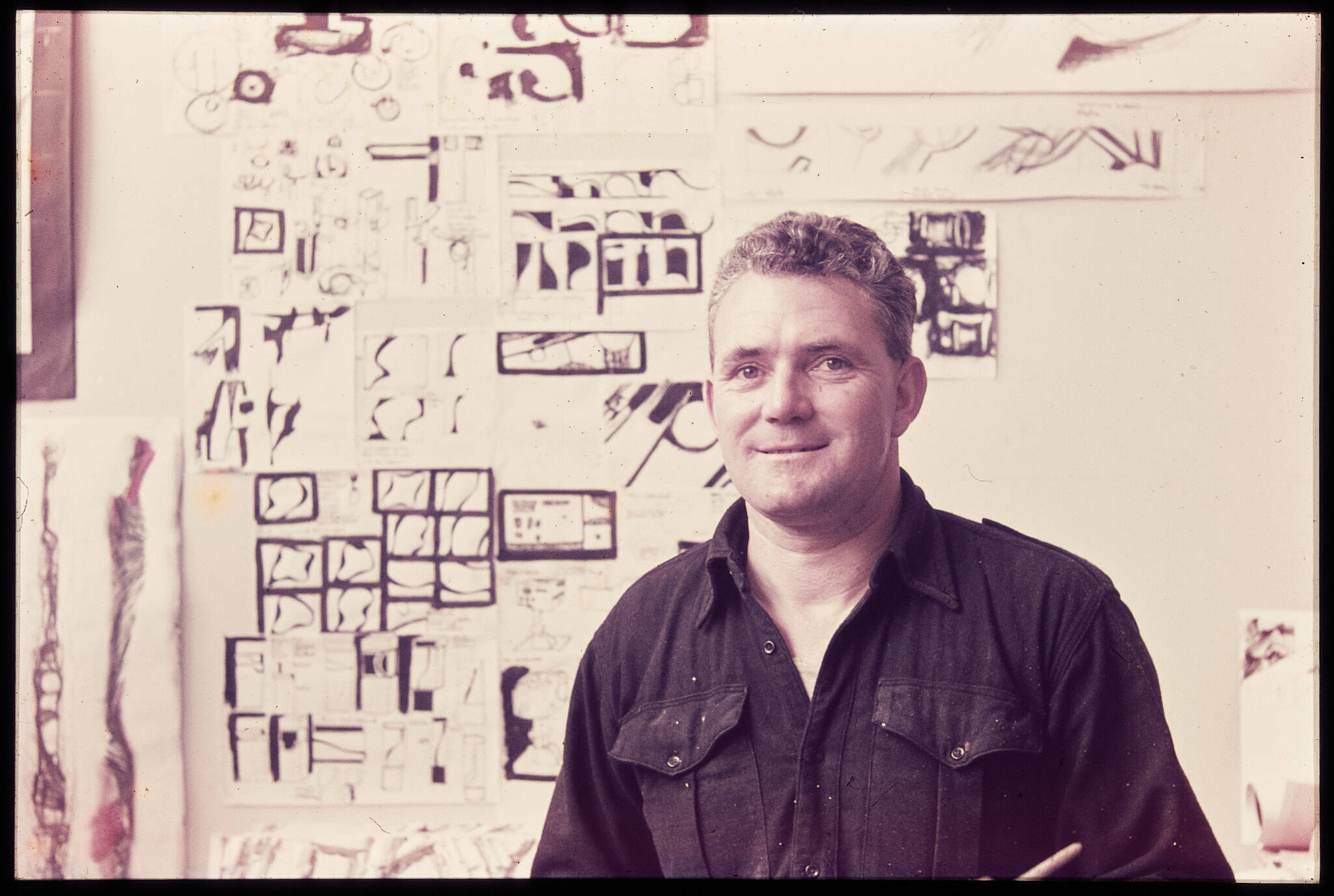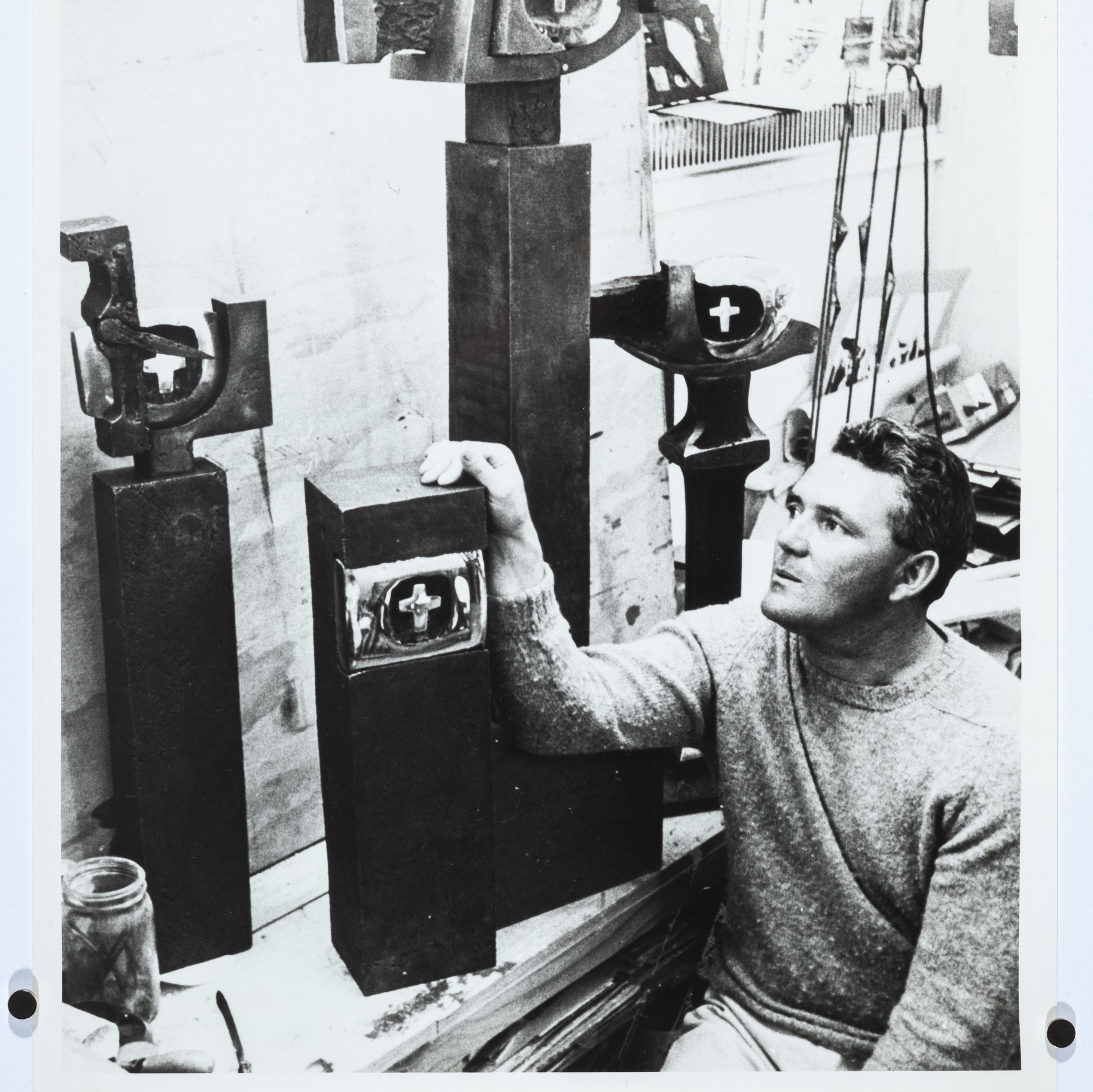Auckland Art Gallery Toi o Tāmaki acknowledges the extraordinary life and work of artist Jim Allen. He passed away last week on Friday 9 June, reaching an incredible 100 years. His story is broad and legendary, and his legacy for arts in the city is profound. Allen had a lasting influence on the establishment of the contemporary art scene in Auckland and a life-long connection to the Auckland Art Gallery. His influence over art of the 1970s aligned it contemporaneously with the dynamic changes occurring globally.
Not only was Allen a veteran of World War II, in which he served as a machine gunner, he was also a skilled sailor, frequently journeying across the Hauraki Gulf and crossing the Tasman more than a dozen times. After the war, Allen resolved to train as an artist, and travelled to London to undertake a degree in sculpture at London’s Royal College of Art, graduating in 1952.
He then returned to New Zealand and committed himself to art education. Alongside his pioneering art practice, Allen is regarded as the most influential art educator of his generation in Aotearoa and Australia, where he was a vital force in shaping the local art scene during the 1960s and 1970s. Employed by New Zealand’s Department of Education as part of the Gordon Tovey-led art education initiative, Allen taught a radical hands-on teaching in schools in the Far North alongside the revolutionary educator Elwyn Richardson – at one time taking a truck load of students’ artworks down from Kaitaia College to exhibit at Auckland Art Gallery.
Allen’s commitment to student-led education informed his tenure as head of sculpture at Elam School of Fine Arts at the University of Auckland (1960–76). Allen is credited with rejuvenating Elam’s sculpture department, with a new emphasis on critical practice, fostering a series of student-led initiatives after witnessing student involvement in the 1968 protests across the United Kingdom, Europe and the United States of America. This in turn spurred the development of a radically new, local contemporary art scene which saw the creation of major sculptural projects in the central city of Auckland, international symposia which generated many public sculpture commissions that can still be seen in the city today, off-site performance events, and a host of young students ready to challenge established norms in art. Describing his approach to teaching, Allen said ‘my effort went into creating a supportive environment, encouraging experiment and exploration, insisting that people find their own answer rather than providing them with one. I guess it was backdoor teaching, not leading from the front.’
As an artist Allen realised several significant sculptural commissions across the country, and was a pioneer of post-object art. For Allen, ‘live’ performance offered an opportunity to directly engage with a rapidly changing world. He instigated Auckland Art Gallery’s first performance art programme, where he realised with a team of students and artists an ambitious three-part work, Contact, timed for the 1974 Auckland Festival. Unlike any previous exhibition at a public gallery in New Zealand, the participating artists did not show individual works of art; instead, they staged actions and performances within temporary sculptural installations, incorporating new video and ‘live playback’ technology to alter how audiences encountered the artworks.
The following year, Allen had a large solo exhibition of his new work O-AR II, 1975, staged at Auckland Art Gallery. In 1976, during his sabbatical year, he undertook a residency at the Experimental Art Foundation in Adelaide, where he continued to develop his performance practice. The same year he participated in the Biennale of Sydney with the performance installation There Are Always Elephants to Be Made Drunk, 1976.
After his time in Adelaide, Allen assumed a position as the founding Head of the Sydney College of the Arts (1977–87).
His eventual return to Auckland in 1998 was once again marked by an engagement with art education (this time at Auckland University of Technology, where he holds an honorary degree) and a re-invigoration of his experimental art practice, with him restaging many key early performance works.
In 2004, Allen was appointed a Member of the New Zealand Order of Merit, for services to education and the arts and in 2015 was awarded the Arts Foundation’s Icon Award Whakamana Hiranga, an honour which recognises the extraordinary achievements and impact of 20 of New Zealand’s most significant artists. His career and influence over New Zealand’s dynamic shifts in contemporary art was examined in the 2018 Auckland Art Gallery exhibition, Groundswell: Avant-Garde Auckland 1971–79.
Auckland Art Gallery Toi o Tāmaki holds a collection of key works by Allen, from his early formal sculpture to his most radical performance works. We are the grateful recipients of his artist archive, held at Whare Pukapuka Rangahau | E H McCormick Research Library, and in 2021 Allen gifted three significant works to the Gallery’s collection in honour of our long-standing relationship: Arena, 1970; Community, 1970; and O-AR II, 1975.
Image credit: Jim Allen, circa 1967 Jim Allen Archive, E H McCormick Research Library, Auckland Art Gallery Toi o Tāmaki, gift of Jim Allen, 2012.

